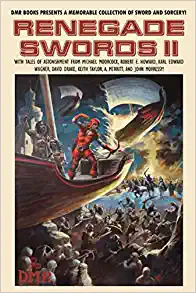 One of life’s pleasures is a well put together anthology of genre fiction. The genre that gives me the most joy to read is sword & sorcery. Sword & sorcery has it all: adventure, supernatural, glamor within a larger than life backdrop. Great reading whether on a cold winter night or sunny Saturday afternoon on the porch swing.
One of life’s pleasures is a well put together anthology of genre fiction. The genre that gives me the most joy to read is sword & sorcery. Sword & sorcery has it all: adventure, supernatural, glamor within a larger than life backdrop. Great reading whether on a cold winter night or sunny Saturday afternoon on the porch swing.
DMR Books has produced another volume in the Renegade Swords series. Editor D. M. Ritzlin loves a good fantastic adventure as much as I do. So much so that he publishes both new and reprint fiction in our exalted genre. Renegade Swords II is an anthology of stories that originally appeared in magazines and long out of print anthologies.
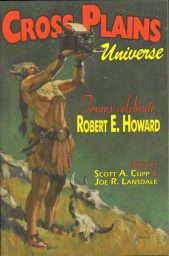 “The Roaming Forest” by Michael Moorcock was originally in Cross Plains Universe (2006), an anthology that was rather good for original fiction. Most original fiction anthologies generally have a much lower batting average. The editors of that book were able to get a new story from Michael Moorcock, this one featuring Rackhir the Red Archer. I had written Moorcock for a while, but he produced some good stories in the last fifteen years that recaptured some of the old magic. There is some fluidity to Moorcock’s multiverse as Rackhir appears to be in ancient Ireland. A princess of Melnibone is involved in the quest for a magic cup.
“The Roaming Forest” by Michael Moorcock was originally in Cross Plains Universe (2006), an anthology that was rather good for original fiction. Most original fiction anthologies generally have a much lower batting average. The editors of that book were able to get a new story from Michael Moorcock, this one featuring Rackhir the Red Archer. I had written Moorcock for a while, but he produced some good stories in the last fifteen years that recaptured some of the old magic. There is some fluidity to Moorcock’s multiverse as Rackhir appears to be in ancient Ireland. A princess of Melnibone is involved in the quest for a magic cup.
“To Rescue Tanelorn” from Michael Moorcock goes all the way back to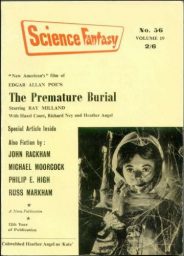 Science Fantasy, Dec. 1962. This was one of the first Moorcock stories I ever read. I was fortunate that my first Moorcock was The Bane of the Black Sword (D.A.W Books) with that great Michael Whelan cover. “To Rescue Tanelorn” is in that collection and featured the character Rackhir the Red Archer instead of Elric.
Science Fantasy, Dec. 1962. This was one of the first Moorcock stories I ever read. I was fortunate that my first Moorcock was The Bane of the Black Sword (D.A.W Books) with that great Michael Whelan cover. “To Rescue Tanelorn” is in that collection and featured the character Rackhir the Red Archer instead of Elric.
“Marchers of Valhalla” has Robert E. Howard in top form. The longest story in 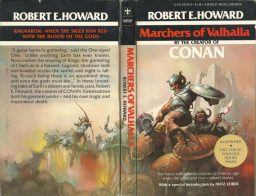 his James Allison series wherein a crippled modern-day man remembers past lives, in this case, a primeval barbarian. First, the opening paragraph:
his James Allison series wherein a crippled modern-day man remembers past lives, in this case, a primeval barbarian. First, the opening paragraph:
“The sky was lurid, gloomy and repellent, of the blue of tarnished steel, streaked with crimson banners. Against the muddled red smear lowered the low hills that are the peaks of that barren upland which is a dreary expanse of sand drifts and post-oak thickets, checkered with sterile fields where tenant farmers toil out their hideously barren lives in fruitless labor and bitter want.”
That is the modern start to the story. Then you get:
“It was so long ago that the yellow-haired folk still dwelt in Nordheim, and were called, not Aryans, but red-haired Vanir and golden-haired Aesir. It was before the great drifts of my race had peopled the world, yet lesser, nameless drifts, had already begun. We were the traveling of years from our northern homeland.”
Robert E. Howard had the epic quality down. You have Nordic barbarians involved in intrigue in the city of Khemu in what is now Texas. The people of Khemu claim descent from the Lemurians. The story has a very apocalyptic ending. Stirring stuff.
“Killer” by David Drake and Karl Edward Wagner was in a small press 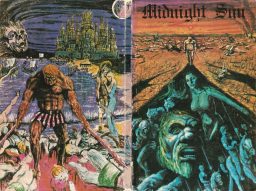 magazine, Midnight Sun #1 (1974). David Drake had written an earlier version called “Hunter’s Moon.” That was lost by an editor of a magazine at the time. Drake then rewrote a draft that was expanded by Wagner. This story was later expanded as a novel in the 80s. This is one of Drake’s Roman stories. Lycon is a hunter of animal for the Roman arena. Sarmatians capture an alien from an ancient Roswell type crash and sell it to the Romans. The creature is intelligent and very dangerous. “Killer” is a fantastic version of the man vs. beast story that was once popular.
magazine, Midnight Sun #1 (1974). David Drake had written an earlier version called “Hunter’s Moon.” That was lost by an editor of a magazine at the time. Drake then rewrote a draft that was expanded by Wagner. This story was later expanded as a novel in the 80s. This is one of Drake’s Roman stories. Lycon is a hunter of animal for the Roman arena. Sarmatians capture an alien from an ancient Roswell type crash and sell it to the Romans. The creature is intelligent and very dangerous. “Killer” is a fantastic version of the man vs. beast story that was once popular.
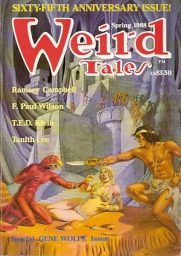 Keith Taylor kept sword & sorcery fiction alive in some tough times in the later 1980s with the Bard and Danans books. He was a consistent presence in the earlier years of the Scithers-Schweitzer Weird Tales. Taylor wrote two stories about Felimid MacFal’s father, Fal. “The Unlawful Hunter” (Weird Tales, Spring 1988) has young Fal part of an outlaw band on a mission of that old Irish pastime of cattle lifting. They come across a hag with a demand.
Keith Taylor kept sword & sorcery fiction alive in some tough times in the later 1980s with the Bard and Danans books. He was a consistent presence in the earlier years of the Scithers-Schweitzer Weird Tales. Taylor wrote two stories about Felimid MacFal’s father, Fal. “The Unlawful Hunter” (Weird Tales, Spring 1988) has young Fal part of an outlaw band on a mission of that old Irish pastime of cattle lifting. They come across a hag with a demand.
 “The Haunting of Mara” (Weird Tales, Fall 1988) is a direct sequel to “The Unlawful Hunter.” Fal faces a sriga, an Irish supernatural parasite. No one is better at writing sword & sorcery with an historical setting.
“The Haunting of Mara” (Weird Tales, Fall 1988) is a direct sequel to “The Unlawful Hunter.” Fal faces a sriga, an Irish supernatural parasite. No one is better at writing sword & sorcery with an historical setting.
There needs to be a collection of those Keith Taylor historical fantasy stories from the Mike Ashley anthologies and Weird Tales.
“The Pool of the Stone God” by A. Merritt (The American Weekly, Sept. 23, 1923). This is almost a vignette of a stone statue in a pool in New Guinea discovered by explorers.
 I told D.M. Ritzlin about “Stoneskin” (F&SF, June 1984) by John Morressy and he tracked it down. The Magazine of Fantasy & Science Fiction under the editorship of Ed Ferman did run a little sword & sorcery fiction now and then. The story made its way into one of the D.A.W. Books Year’s Best Fantasy anthologies which is where I first read the story. A traveling swordsman receives a magical glove that makes him impervious to weapons in combat.
I told D.M. Ritzlin about “Stoneskin” (F&SF, June 1984) by John Morressy and he tracked it down. The Magazine of Fantasy & Science Fiction under the editorship of Ed Ferman did run a little sword & sorcery fiction now and then. The story made its way into one of the D.A.W. Books Year’s Best Fantasy anthologies which is where I first read the story. A traveling swordsman receives a magical glove that makes him impervious to weapons in combat.
If you are depressed from reading too much Philip K. Dick, Renegade Swords II is an excellent antidote to lift the spirits.
“DMR Books has produced another volume in the Renegade Swords series. (…) If you are depressed from reading too much Philip K. Dick, Renegade Swords II is an excellent antidote to lift the spirits.”
Yeah, this is a fine antho. Hard to pick the best one between this and the previous volume.
‘Marchers of Valhalla’ has been one of my absolute favorite REH tales ever since I read it as a freshman in high school. The textbook definition of ‘blood and thunder’.
“The people of Khemu claim descent from the Lemurians.”
Well, they CLAIM it, but Ishtar resoundingly debunks that claim…and she should know. It would be akin to Filipinos claiming to be actual Spaniards. The Khemuri are of the ‘Khemite’ stock from which sprang the proto-Stygians who dominated the east coast of the Thurian continent during the age of Kull.
The Lemurian Empire–long after Kull’s reign–eventually extended all the way from the western Pacific to what would become the Texas coast, but their cultural imperialism only went skin-deep. It didn’t even make as much impact, in relative terms, as the British Raj did on India.